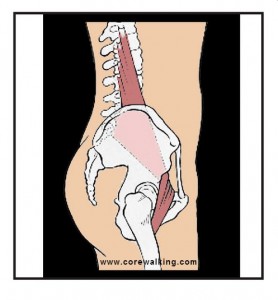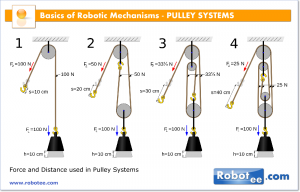While I think I am pretty darned smart there is clearly much I don’t know. And much of what I do know I have read somewhere or other, integrated it onto my lizard brain and regurgitated as a theory that I think works in the context of what I do.
This is the essential germ of one my main/favorite topics—the psoas is a pulley system in the body. There are many pulley systems in the body. The psoas is one of them. The hip bone is the pulley and the psoas is the rope. The ankle bone is a pulley and the peroneal muscles are the rope. The quadriceps muscle also acts like a pulley system.
In one particular post and in my book Psoas Release Party!, I discuss the idea that a pulley helps to generate additional force and when the psoas is well aligned and working well this helps support the upright spine. I refer to the psoas as a pulley system often but only mention the additional force aspect here and there, though it was always implied in my mind.
And then in humbling fashion I was delivered a wake-up call. Last week just I was heading off to bed one night I made the usual mistake of checking my emails. Sitting in my inbox was an email from Nina L, a yoga teacher who also happens to be a structural engineer. She informed me in no uncertain terms that my take on the psoas as a pulley system was all wet.
Nina provided me with an excellent link that explained where I was wrong. The psoas does act like a pulley system but not one designed to help generate greater force making something easier to lift or move. When there is a single pulley greater force is not in fact generated. Two pulleys would need to be employed for that to happen, and the psoas is only a single pulley.
This fact doesn’t undermine my idea completely as the psoas is a pulley system, though is doesn’t help to generate greater force unto itself. That lift that I talk about the psoas bringing to the spine comes from the phenomenon of reciprocal inhibition, which means that for one muscle to lengthen, another must shorten.
In the case of the psoas, when it engages drawing the lumbar spine forward, the erector spinea muscles of the spine engage and lengthen up the back, extending the spine to its fullest capability. When the psoas is not aligned properly this reciprocal inhibition fails to occur and to a degree the spine collapses on itself and the head and neck lose all support.
I think this is pretty easy to feel when one tucks and untucks their pelvis when standing. An untucked pelvis that is correctly aligned sets up the psoas to act like a pulley and allows for reciprocal inhibition to kick in. When the pelvis tucks under the psoas is no longer aligned like a pulley and reciprocal inhibition won’t happen with the spinal muscles because the psoas does not shorten or engage.
It is fairly intense writing a blog the way I do because insecurity hides behind every door and I am always expecting emails that tell me how wrong I am such as the one from Nina. While my first reaction is often low grade shame, embarrassment and resistance I try to be open minded and explore what other people have to offer.
I have learned so much this way and truly value everyone who reads the blog and shares there insights with me. As much as I always think I am right about everything I know deep down how silly that is. So thank you Nina, and everyone else who assists me on the path.


